Institute of Forest Ecology, Slovak Academy of Science, Branch for Woody Plants Biology Nitra, Slovak Republic.
Institute of Plant Genetic and Biotechnology, SAS, Nitra, Slovak Republic, Scientific researcher (2006 – 2008)
Constantine the Philosopher University, Faculty of Natural Sciences, Department of Botany and Genetics, Nitra, Slovak Republic, PhD. student, (2006 – 2002)
2025
|
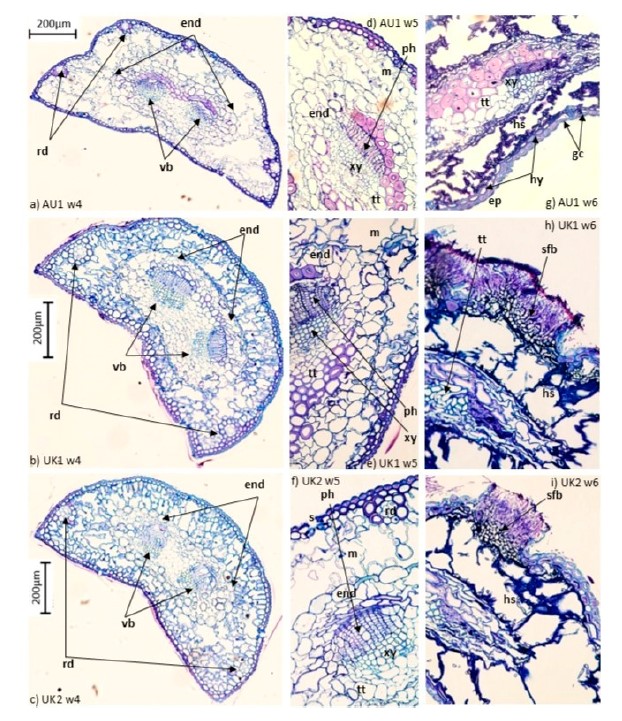 | Jánošíková, Z; Adamčíková, K; Ondrušková, E; Ostrovský, R; Woodward, S; Fraser, S Histological Analysis of Dothistroma septosporum Infection on Different Provenances of Pinus sylvestris Journal Article Forests, 16 , pp. 973, 2025, ISSN: 1999-4907. Abstract | Links | BibTeX @article{Jánošíková2025,
title = {Histological Analysis of Dothistroma septosporum Infection on Different Provenances of Pinus sylvestris},
author = {Z. Jánošíková and K. Adamčíková and E. Ondrušková and R. Ostrovský and S. Woodward and S. Fraser},
url = {http://ife.sk/wp-content/uploads/2020/09/fig-5.jpg},
doi = {10.3390/f16060973},
issn = {1999-4907},
year = {2025},
date = {2025-06-09},
journal = {Forests},
volume = {16},
pages = {973},
abstract = {Dothistroma needle blight (DNB) is one of the most significant diseases of conifers, causing premature defoliation, growth reduction, and, in extreme cases, mortality. Histological analysis was undertaken on inoculated seedlings of three different seed sources of Pinus sylvestris L. to investigate the process of infection and degradation of needle tissue on this host species. Seedlings were inoculated using a single spore isolate of Dothistroma septosporum (Doroguine) M. Morelet (D636) from northern Scotland. Mesophyll degradation in the needles occurred by four weeks after inoculation; collapse of mesophyll, bundle sheath tissues, and tracheids by five weeks; and eruption of fruiting bodies in near proximity to stomatal openings by six weeks. Significantly greater collapse of mesophyll during the early stages of infection occurred in the Austrian provenance compared with the United Kingdom provenance, although in the later stages of infection, this difference disappeared. Furthermore, disease severity, assessed as the proportion of needles with D. septosporum conidiomata on each tree, was not significantly different between seed sources.},
keywords = {},
pubstate = {published},
tppubtype = {article}
}
Dothistroma needle blight (DNB) is one of the most significant diseases of conifers, causing premature defoliation, growth reduction, and, in extreme cases, mortality. Histological analysis was undertaken on inoculated seedlings of three different seed sources of Pinus sylvestris L. to investigate the process of infection and degradation of needle tissue on this host species. Seedlings were inoculated using a single spore isolate of Dothistroma septosporum (Doroguine) M. Morelet (D636) from northern Scotland. Mesophyll degradation in the needles occurred by four weeks after inoculation; collapse of mesophyll, bundle sheath tissues, and tracheids by five weeks; and eruption of fruiting bodies in near proximity to stomatal openings by six weeks. Significantly greater collapse of mesophyll during the early stages of infection occurred in the Austrian provenance compared with the United Kingdom provenance, although in the later stages of infection, this difference disappeared. Furthermore, disease severity, assessed as the proportion of needles with D. septosporum conidiomata on each tree, was not significantly different between seed sources. |
2024
|
| Ondrušková, E; Kobza, M; Jánošíková, Z; McDougal, R; Adamčíková, K Which Cyclaneusma minus morphotypes are responsible for needle cast of Pinus sp. in Slovakia? Journal Article Journal of Plant Diseases and Protection, 131 , pp. 1665–1672, 2024, ISSN: 1861-3829. Abstract | Links | BibTeX @article{Ondrušková2024,
title = {Which Cyclaneusma minus morphotypes are responsible for needle cast of Pinus sp. in Slovakia?},
author = {E. Ondrušková and M. Kobza and Z. Jánošíková and R. McDougal and K. Adamčíková},
doi = {https://doi.org/10.1007/s41348-024-00924-y},
issn = {1861-3829},
year = {2024},
date = {2024-05-10},
journal = {Journal of Plant Diseases and Protection},
volume = {131},
pages = {1665–1672},
abstract = {Cyclaneusma needle cast (CNC) is a needle disease which caused deterioration of vitality and reduction in the growth of pines. The disease is caused by the ascomycetous fungus Cyclaneusma minus, which has two well-described morphotypes; C. minus simile and C. minus verum. The distribution and host range of C. minus simile and verum was determined from needle samples and isolates collected throughout Slovakia from 2014 to 2020. Samples from 111 localities, 11 pine host species and 245 trees collected in different types of planting were analysed. It was found, that both morphotypes are present, but C. minus verum is predominantly responsible for CNC in urban and forest plantings in Slovakia. C. minus verum was positively detected in more than 88% of collected samples, whereas C. minus simile was only in four samples from three localities. Morphotype-specific primers were sufficiently sensitive even for new pine-host species. The host range of C. minus simile and C. minus verum was enriched worldwide. C. minus verum was observed in nine host species, whereas C. minus simile was identified only in one. Cyclaneusma niveum was also recorded and its presence was confirmed through DNA sequencing.},
keywords = {},
pubstate = {published},
tppubtype = {article}
}
Cyclaneusma needle cast (CNC) is a needle disease which caused deterioration of vitality and reduction in the growth of pines. The disease is caused by the ascomycetous fungus Cyclaneusma minus, which has two well-described morphotypes; C. minus simile and C. minus verum. The distribution and host range of C. minus simile and verum was determined from needle samples and isolates collected throughout Slovakia from 2014 to 2020. Samples from 111 localities, 11 pine host species and 245 trees collected in different types of planting were analysed. It was found, that both morphotypes are present, but C. minus verum is predominantly responsible for CNC in urban and forest plantings in Slovakia. C. minus verum was positively detected in more than 88% of collected samples, whereas C. minus simile was only in four samples from three localities. Morphotype-specific primers were sufficiently sensitive even for new pine-host species. The host range of C. minus simile and C. minus verum was enriched worldwide. C. minus verum was observed in nine host species, whereas C. minus simile was identified only in one. Cyclaneusma niveum was also recorded and its presence was confirmed through DNA sequencing. |
 | Jánošíková, Z; Kobza, M; Ondrušková, E; Ostrovský, R; Pažitný, J; Adamčíková, K Virulence of Dothistroma septosporum and D. pini on Pinus nigra and P. mugo under conditions of natural infection Journal Article European Journal of Plant Pathology, 168 (2), pp. 775-785, 2024. Abstract | Links | BibTeX @article{Jánošíková2024,
title = {Virulence of Dothistroma septosporum and D. pini on Pinus nigra and P. mugo under conditions of natural infection},
author = {Z. Jánošíková and M. Kobza and E. Ondrušková and R. Ostrovský and J. Pažitný and K. Adamčíková},
url = {http://ife.sk/wp-content/uploads/2020/09/Fig_edited.jpghttp://ife.sk/wp-content/uploads/2020/09/final-1-2.jpg},
doi = {https://doi.org/10.1007/s10658-023-02799-5},
year = {2024},
date = {2024-04-04},
journal = {European Journal of Plant Pathology},
volume = {168},
number = {2},
pages = {775-785},
abstract = {Dothistroma needle blight (DNB) is a severe needle disease of pines worldwide, caused by two closely related species, Dothistroma septosporum and D. pini. The two fungal species are similar not only in their morphological characteristics, but also cause very similar symptoms in their hosts, and have a similar ecology. The aim of this study was to compare the virulence of the two Dothistroma species in natural infection experiments on 2-year-old seedlings of two DNB susceptible pine species, Pinus nigra and P. mugo, in two seedling stands for each pathogen species. The virulence of the pathogens and presence of symptoms (symptomatic needles, red bands and acervuli) were assessed after 2 years of exposure to inoculum. The incidence of seedlings with DNB symptoms was 65% and 76% for P. nigra and P. mugo, respectively. No difference was found between D. septosporum and D. pini in any of the three DNB symptoms evaluated on seedlings of P. mugo. However, symptoms of disease differed between the two Dothistroma species on P. nigra. Variables, which reflect the intensity of disease development, the number of red bands and acervuli per needle, showed a difference in virulence between D. septosporum and D. pini, but only in the case of the host species P. nigra. The results suggest that the virulence of the two Dothistroma species could be affected by host pine species and that there are differences in susceptibility of individual pine species to D. septosporum and D. pini. Further factors could affect the virulence of these pathogens, including isolate origin, climatic or environmental factors.},
keywords = {},
pubstate = {published},
tppubtype = {article}
}
Dothistroma needle blight (DNB) is a severe needle disease of pines worldwide, caused by two closely related species, Dothistroma septosporum and D. pini. The two fungal species are similar not only in their morphological characteristics, but also cause very similar symptoms in their hosts, and have a similar ecology. The aim of this study was to compare the virulence of the two Dothistroma species in natural infection experiments on 2-year-old seedlings of two DNB susceptible pine species, Pinus nigra and P. mugo, in two seedling stands for each pathogen species. The virulence of the pathogens and presence of symptoms (symptomatic needles, red bands and acervuli) were assessed after 2 years of exposure to inoculum. The incidence of seedlings with DNB symptoms was 65% and 76% for P. nigra and P. mugo, respectively. No difference was found between D. septosporum and D. pini in any of the three DNB symptoms evaluated on seedlings of P. mugo. However, symptoms of disease differed between the two Dothistroma species on P. nigra. Variables, which reflect the intensity of disease development, the number of red bands and acervuli per needle, showed a difference in virulence between D. septosporum and D. pini, but only in the case of the host species P. nigra. The results suggest that the virulence of the two Dothistroma species could be affected by host pine species and that there are differences in susceptibility of individual pine species to D. septosporum and D. pini. Further factors could affect the virulence of these pathogens, including isolate origin, climatic or environmental factors. |
2023
|
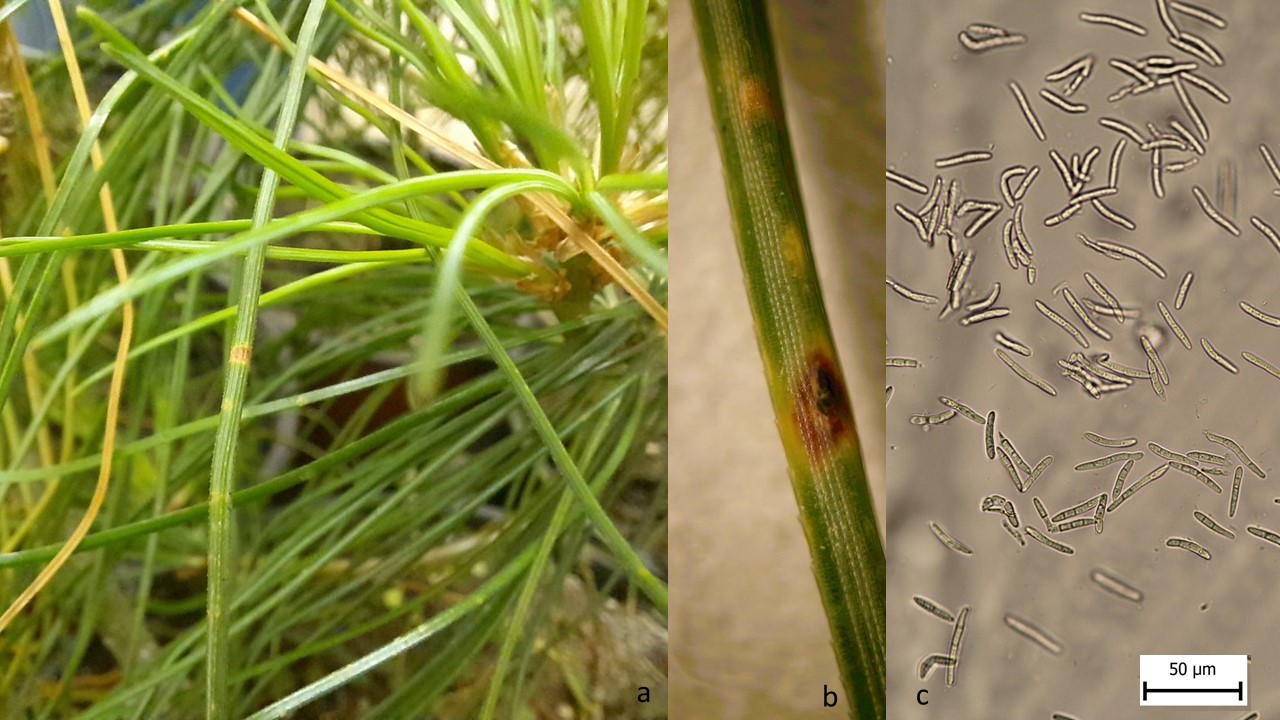 | Jánošíková, Z; Ondrušková, E; Adamčíková, K Artificial inoculation and susceptibility of Pinus armandii to Dothistroma septosporum Journal Article Forest Pathology, 53 (5), pp. e12826, 2023, ISSN: 1439-0329. Abstract | Links | BibTeX @article{Jánošíková2023b,
title = {Artificial inoculation and susceptibility of Pinus armandii to Dothistroma septosporum},
author = {Z. Jánošíková and E. Ondrušková and K. Adamčíková},
doi = {DOI: 10.1111/efp.12826 },
issn = {1439-0329},
year = {2023},
date = {2023-08-18},
journal = {Forest Pathology},
volume = {53},
number = {5},
pages = {e12826},
abstract = {Dothistroma needle blight (DNB) is a serious needle disease of conifers that primarily affects pine species (Pinus spp.). Dothistroma septosporum is one of the DNB patho�gens that has a diverse range of host species excluding Pinus armandii. In 15 inoculated P. armandii seedlings, D. septosporum acervuli were observed in 43 infected needles of ten seedlings with a mean disease severity of 1.11% at 25 weeks after inoculations, demonstrating the potential of D. septosporum to cause symptoms on the needles of P. armandii via artificial inoculation. The disease severity of P. armandii was similar to
the positive control, Pinus nigra (median 0.75 for P. armandii to 0.70 for P. nigra), thus, P. armandii acts under artificial conditions as a susceptible host species.},
keywords = {},
pubstate = {published},
tppubtype = {article}
}
Dothistroma needle blight (DNB) is a serious needle disease of conifers that primarily affects pine species (Pinus spp.). Dothistroma septosporum is one of the DNB patho�gens that has a diverse range of host species excluding Pinus armandii. In 15 inoculated P. armandii seedlings, D. septosporum acervuli were observed in 43 infected needles of ten seedlings with a mean disease severity of 1.11% at 25 weeks after inoculations, demonstrating the potential of D. septosporum to cause symptoms on the needles of P. armandii via artificial inoculation. The disease severity of P. armandii was similar to
the positive control, Pinus nigra (median 0.75 for P. armandii to 0.70 for P. nigra), thus, P. armandii acts under artificial conditions as a susceptible host species. |
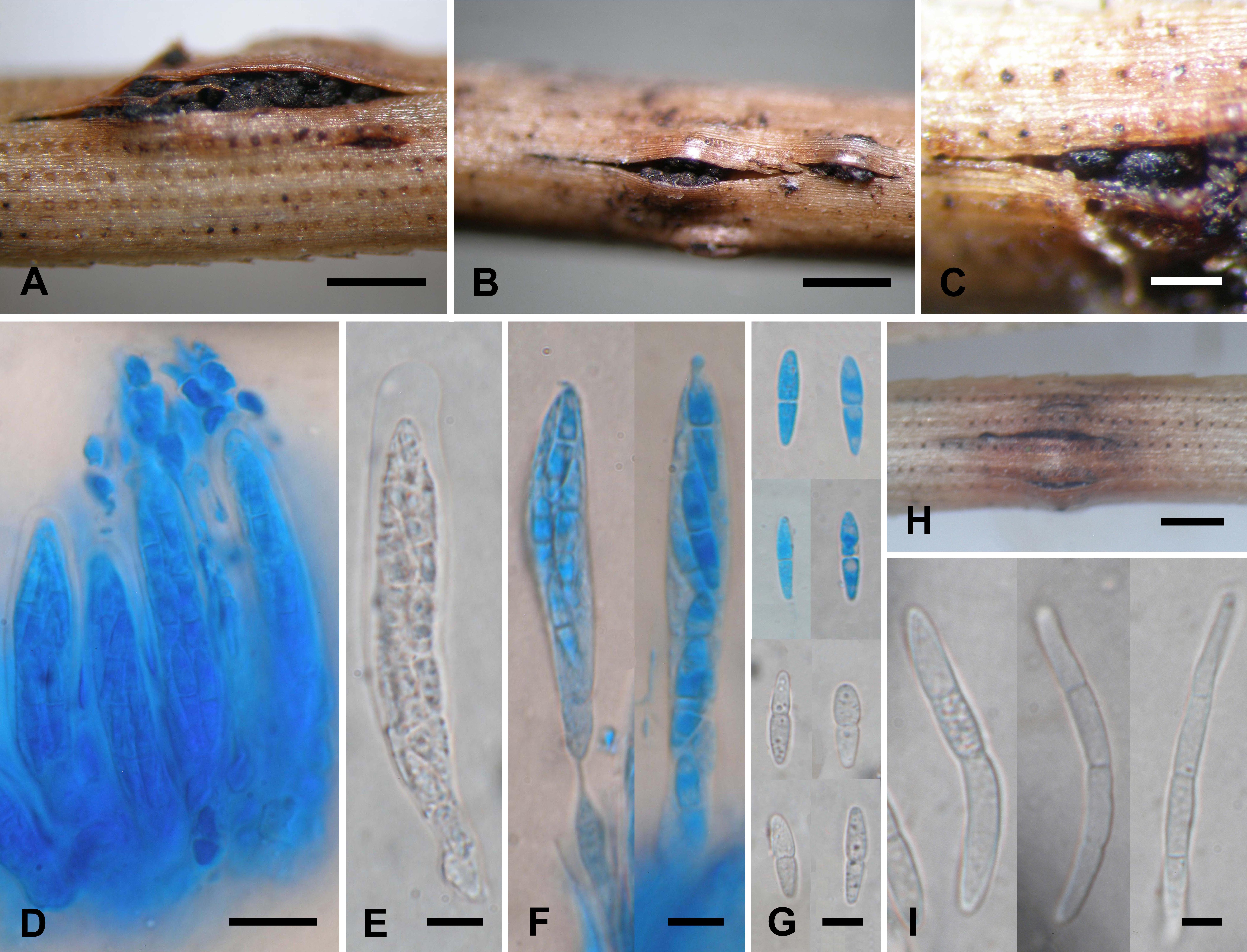 | Adamčíková, K; Pastirčáková, K; Jánošíková, Z; Ostrovský, R; Pastirčák, M; Pažitný, J; Kobza, M; Adamčík, S; Kádasi-Horáková, M; Ondrušková, E New regional records of Dothistroma needle blight pathogens from Slovakia: distribution, hosts and pathogens characterization Journal Article Annals of Forest Research, 66 (1), pp. 99-111, 2023, ISSN: 1844-8135. Abstract | Links | BibTeX @article{Adamčíková2023,
title = {New regional records of Dothistroma needle blight pathogens from Slovakia: distribution, hosts and pathogens characterization},
author = {K. Adamčíková and K. Pastirčáková and Z. Jánošíková and R. Ostrovský and M. Pastirčák and J. Pažitný and M. Kobza and S. Adamčík and M. Kádasi-Horáková and E. Ondrušková},
doi = {https://doi.org/10.15287/afr.2023.2427},
issn = {1844-8135},
year = {2023},
date = {2023-07-25},
journal = {Annals of Forest Research},
volume = {66},
number = {1},
pages = {99-111},
abstract = {Dothistroma needle blight is one of the most severe needle diseases of pines caused by two closely related species, Dothistroma septosporum and D. pini. The further spread and distribution of this disease was investigated in Slovakia as well as new hosts and stand types were identified at regional level. Dothistroma septosporum was recorded in a natural stand at higher altitude on Pinus cembra in the High Tatras and the P. uncinata records are new host reports for Slovakia for this pathogen. Moreover, for D. pini, P. cembra as a new host at the country level was recorded and P. armandii was identified as new host species worldwide. Mating types for all collected samples and ITS haplotypes for D. pini isolates were determined. For D. pini, five localities with the presence of both mating types and three ITS haplotypes (Dp_HAP.1, Dp_HAP.2 and Dp_HAP.4) were reported. Samples where both mating types of the pathogens were identified, were selected for the microscopic examination of fruiting bodies aimed to detect sexual reproductive organs. In all inspected needle samples of D. pini, only conidiomata with typical hyaline cylindrical conidia were identified. The sexual state of D. septosporum was recorded in one sample of P. nigra needles.},
keywords = {},
pubstate = {published},
tppubtype = {article}
}
Dothistroma needle blight is one of the most severe needle diseases of pines caused by two closely related species, Dothistroma septosporum and D. pini. The further spread and distribution of this disease was investigated in Slovakia as well as new hosts and stand types were identified at regional level. Dothistroma septosporum was recorded in a natural stand at higher altitude on Pinus cembra in the High Tatras and the P. uncinata records are new host reports for Slovakia for this pathogen. Moreover, for D. pini, P. cembra as a new host at the country level was recorded and P. armandii was identified as new host species worldwide. Mating types for all collected samples and ITS haplotypes for D. pini isolates were determined. For D. pini, five localities with the presence of both mating types and three ITS haplotypes (Dp_HAP.1, Dp_HAP.2 and Dp_HAP.4) were reported. Samples where both mating types of the pathogens were identified, were selected for the microscopic examination of fruiting bodies aimed to detect sexual reproductive organs. In all inspected needle samples of D. pini, only conidiomata with typical hyaline cylindrical conidia were identified. The sexual state of D. septosporum was recorded in one sample of P. nigra needles. |
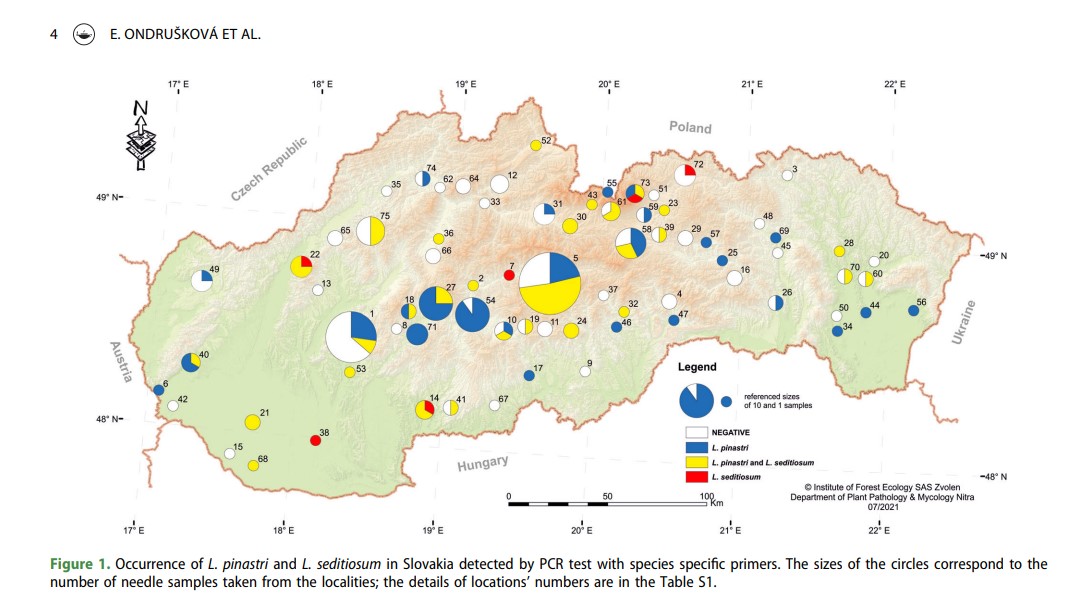 | Ondrušková, E; Adamčík, S; Kobza, M; Jánošíková, Z; Ostrovský, R; Pastirčáková, K; Caboň, M; Adamčíková, K Checking the balance between pathogenic and mutualistic pine needle fungi of the genus Lophodermium in forested and urban areas of Slovakia Journal Article Scandinavian Journal of Forest Research, 38 (1-2), pp. 39-48, 2023, ISSN: 1651-1891. Abstract | Links | BibTeX @article{Ondrušková2023,
title = {Checking the balance between pathogenic and mutualistic pine needle fungi of the genus Lophodermium in forested and urban areas of Slovakia},
author = {E. Ondrušková and S. Adamčík and M. Kobza and Z. Jánošíková and R. Ostrovský and K. Pastirčáková and M. Caboň and K. Adamčíková
},
doi = { DOI: 10.1080/02827581.2023.2191004},
issn = {1651-1891},
year = {2023},
date = {2023-03-27},
journal = {Scandinavian Journal of Forest Research},
volume = {38},
number = {1-2},
pages = {39-48},
abstract = {Lophodermium species are well known to be among dominant endophytic fungi colonising pine needles. Occurrence of two species with different life strategies on different Pinus trees across Slovakia was detected by PCR using species specific primers. In general, commensalistic species L. pinastri was more frequent than parasitic L. seditiosum. There were no significant differences observed between urban and natural environments, but natural environments have more frequent colonisation by L. pinastri and less frequent were trees negatively tested to Lophodermium colonisation. Among the most frequently sampled trees were non-native P. nigra and native P. sylvestris. Significant difference in Lophodermium incidence was detected between these two species in natural environment, with increased frequency of L. pinastri on native Scots pine. In addition to one clade of L. pinastri, culture based species identification confirmed presence of L. corconticum and an undescribed clade of L. seditiosum that is not sensitive to used PCR primers for the species detection.},
keywords = {},
pubstate = {published},
tppubtype = {article}
}
Lophodermium species are well known to be among dominant endophytic fungi colonising pine needles. Occurrence of two species with different life strategies on different Pinus trees across Slovakia was detected by PCR using species specific primers. In general, commensalistic species L. pinastri was more frequent than parasitic L. seditiosum. There were no significant differences observed between urban and natural environments, but natural environments have more frequent colonisation by L. pinastri and less frequent were trees negatively tested to Lophodermium colonisation. Among the most frequently sampled trees were non-native P. nigra and native P. sylvestris. Significant difference in Lophodermium incidence was detected between these two species in natural environment, with increased frequency of L. pinastri on native Scots pine. In addition to one clade of L. pinastri, culture based species identification confirmed presence of L. corconticum and an undescribed clade of L. seditiosum that is not sensitive to used PCR primers for the species detection. |
2021
|
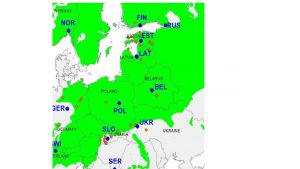 | Adamson, K; Laas, M; Blumenstein, K; Busskamp, J; Langer, G J; Klavina, D; Kaur, A; Maaten, T; Mullett, M S; Müller, M M; Ondrušková, E; Padari, A; Pilt, E; Riit, T; Solheim, H; Soonvald, L; Tedersoo, L; Terhonen, E; Drenkhan, R Highly Clonal Structure and Abundance of One Haplotype Characterise the Diplodia sapinea Populations in Europe and Western Asia Journal Article Journal of Fungi, 7 (8), pp. 634, 2021, ISBN: EISSN 2309-608X. Abstract | Links | BibTeX @article{K.2021,
title = {Highly Clonal Structure and Abundance of One Haplotype Characterise the Diplodia sapinea Populations in Europe and Western Asia},
author = {K. Adamson and M. Laas and K. Blumenstein and J. Busskamp and G.J. Langer and D. Klavina and A. Kaur and T. Maaten and M.S. Mullett and M.M. Müller and E. Ondrušková and A. Padari and E. Pilt and T. Riit and H. Solheim and L. Soonvald and L. Tedersoo and E. Terhonen and R. Drenkhan},
editor = {David S. Perlin},
url = { https://www.mdpi.com/2309-608X/7/8/634/pdf
},
doi = {https://doi.org/10.3390/jof7080634},
isbn = { EISSN 2309-608X},
year = {2021},
date = {2021-08-04},
journal = {Journal of Fungi},
volume = {7},
number = {8},
pages = {634},
abstract = {Diplodia sapinea is a cosmopolitan endophyte and opportunistic pathogen having occurred on several conifer species in Europe for at least 200 years. In Europe, disease outbreaks have increased on several Pinus spp. in the last few decades. In this study, the genetic structure of the European and western Asian D. sapinea population were investigated using 13 microsatellite markers. In total, 425 isolates from 15 countries were analysed. A high clonal fraction and low genetic distance between most subpopulations was found. One single haplotype dominates the European population, being represented by 45.3% of all isolates and found in nearly all investigated countries. Three genetically distinct subpopulations were found: Central/North European, Italian and Georgian. The recently detected subpopulations of D. sapinea in northern Europe (Estonia) share several haplotypes with the German subpopulation. The northern European subpopulations (Latvia, Estonia and Finland) show relatively high genetic diversity compared to those in central Europe suggesting either that the fungus has existed in the North in an asymptomatic/endophytic mode for a long time or that it has spread recently by multiple introductions. Considerable genetic diversity was found even among isolates of a single tree as 16 isolates from a single tree resulted in lower clonal fraction index
than most subpopulations in Europe, which might reflect cryptic sexual proliferation. According to currently published allelic patterns, D. sapinea most likely originates from North America or from some unsampled population in Asia or central America. In order to enable the detection of endophytic or latent infections of planting stock by D. sapinea, new species-specific PCR primers (DiSapi-F and Diplo-R) were designed. During the search for Diplodia isolates across the world for species specific primer development, we identified D. africana in California, USA, and in the Canary Islands, which are the first records of this species in North America and in Spain.
},
keywords = {},
pubstate = {published},
tppubtype = {article}
}
Diplodia sapinea is a cosmopolitan endophyte and opportunistic pathogen having occurred on several conifer species in Europe for at least 200 years. In Europe, disease outbreaks have increased on several Pinus spp. in the last few decades. In this study, the genetic structure of the European and western Asian D. sapinea population were investigated using 13 microsatellite markers. In total, 425 isolates from 15 countries were analysed. A high clonal fraction and low genetic distance between most subpopulations was found. One single haplotype dominates the European population, being represented by 45.3% of all isolates and found in nearly all investigated countries. Three genetically distinct subpopulations were found: Central/North European, Italian and Georgian. The recently detected subpopulations of D. sapinea in northern Europe (Estonia) share several haplotypes with the German subpopulation. The northern European subpopulations (Latvia, Estonia and Finland) show relatively high genetic diversity compared to those in central Europe suggesting either that the fungus has existed in the North in an asymptomatic/endophytic mode for a long time or that it has spread recently by multiple introductions. Considerable genetic diversity was found even among isolates of a single tree as 16 isolates from a single tree resulted in lower clonal fraction index
than most subpopulations in Europe, which might reflect cryptic sexual proliferation. According to currently published allelic patterns, D. sapinea most likely originates from North America or from some unsampled population in Asia or central America. In order to enable the detection of endophytic or latent infections of planting stock by D. sapinea, new species-specific PCR primers (DiSapi-F and Diplo-R) were designed. During the search for Diplodia isolates across the world for species specific primer development, we identified D. africana in California, USA, and in the Canary Islands, which are the first records of this species in North America and in Spain.
|
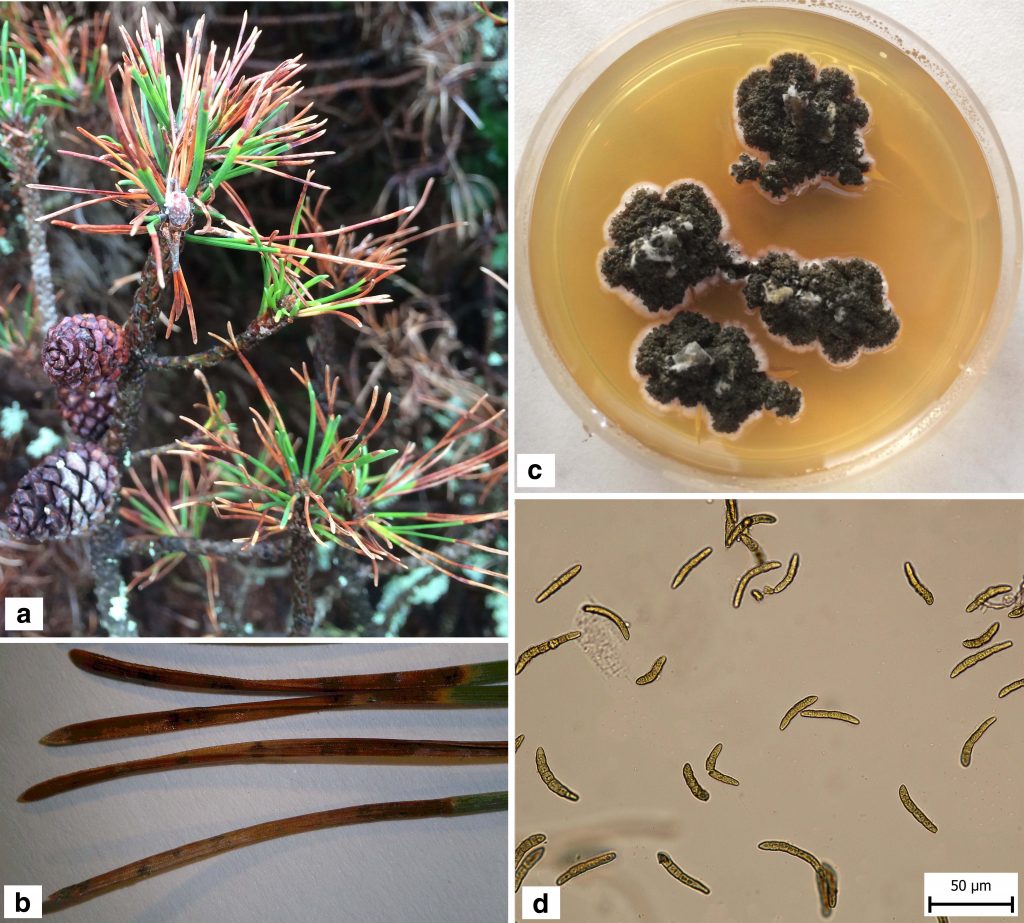 | Adamčíková, K; Jánošíková, Z; Adamčík, S; Ostrovský, R; Pastirčáková, K; Kobza, M; Ondrušková, E Host range, genetic variability, and mating types of Lecanosticta acicola in Slovakia Journal Article Scandinavian Journal of Forest Research, 36 (5), pp. 325-332, 2021, ISSN: 0282-7581. Abstract | Links | BibTeX @article{Adamčíková2021b,
title = {Host range, genetic variability, and mating types of \textit{Lecanosticta acicola} in Slovakia},
author = {K. Adamčíková and Z. Jánošíková and S. Adamčík and R. Ostrovský and K. Pastirčáková and M. Kobza and E. Ondrušková},
url = {https://doi.org/10.1080/02827581.2021.1941236},
doi = {10.1080/02827581.2021.1941236},
issn = {0282-7581},
year = {2021},
date = {2021-07-16},
journal = {Scandinavian Journal of Forest Research},
volume = {36},
number = {5},
pages = {325-332},
abstract = {In recent years, there has been an apparent Europe-wide emerging presence of brown spot needle blight, a disease of pine species caused by the fungus Lecanosticta acicola. In this study, we report the first well-documented occurrences of the pathogen in Slovakia, identified molecularly using species-specific primers and based on sequencing of the ITS region and TEF1 gene. Among the material collected from 84 locations within the country, L. acicola was present in 17 samples from 13 different locations, mainly distributed in urban environments. Four pine species were identified as hosts, among which, Pinus nigra and P. mugo were found to be the most frequently infected. Analysis of the mating type genes of 24 isolates obtained from two localities revealed the presence of a single mating type in Slovakia. All analyzed ITS sequences of the Slovak isolates were found to be uniform. However, although analysis of the TEF1 gene indicated that all Slovak isolates could be grouped into a single lineage, we detected nucleotide polymorphisms suggestive of a certain degree of genetic diversification within central European populations of the fungus.},
keywords = {},
pubstate = {published},
tppubtype = {article}
}
In recent years, there has been an apparent Europe-wide emerging presence of brown spot needle blight, a disease of pine species caused by the fungus Lecanosticta acicola. In this study, we report the first well-documented occurrences of the pathogen in Slovakia, identified molecularly using species-specific primers and based on sequencing of the ITS region and TEF1 gene. Among the material collected from 84 locations within the country, L. acicola was present in 17 samples from 13 different locations, mainly distributed in urban environments. Four pine species were identified as hosts, among which, Pinus nigra and P. mugo were found to be the most frequently infected. Analysis of the mating type genes of 24 isolates obtained from two localities revealed the presence of a single mating type in Slovakia. All analyzed ITS sequences of the Slovak isolates were found to be uniform. However, although analysis of the TEF1 gene indicated that all Slovak isolates could be grouped into a single lineage, we detected nucleotide polymorphisms suggestive of a certain degree of genetic diversification within central European populations of the fungus. |
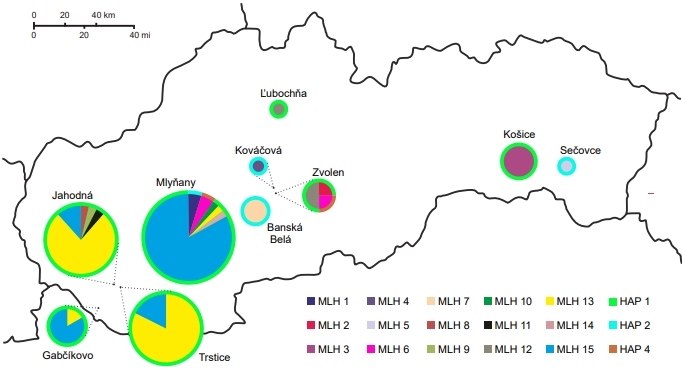 | Adamčíková, K; Jánošíková, Z; van der Nest, A; Adamčík, S; Ondrušková, E; Barnes, I Population structure and genetic diversity suggest recent introductions of Dothistroma pini in Slovakia Journal Article Plant Pathology, 70 (8), pp. 1883-1896, 2021, ISSN: 1365-3059. Abstract | Links | BibTeX @article{Adamčíková2021c,
title = {Population structure and genetic diversity suggest recent introductions of Dothistroma pini in Slovakia},
author = {K. Adamčíková and Z. Jánošíková and A. van der Nest and S. Adamčík and E. Ondrušková and I. Barnes },
url = {https://bsppjournals.onlinelibrary.wiley.com/doi/10.1111/ppa.13428},
doi = {10.1111/ppa.13428},
issn = {1365-3059},
year = {2021},
date = {2021-06-30},
journal = {Plant Pathology},
volume = {70},
number = {8},
pages = {1883-1896},
abstract = {Dothistroma pini is one of two pathogens causing Dothistroma needle blight (DNB), a foliar disease of pines. The species was redefined in 2004 and subsequently recorded in several European countries. In Slovakia, the first report of the pathogen was in 2013. In this study, the population structure, genetic diversity, and reproductive mode of 105 isolates collected from 10 localities and seven hosts were determined in Slovakia. Species-specific mating type markers, ITS haplotype determination, and 16 microsatellite markers were used to characterize and genotype the isolates. Overall, 15 unique multilocus haplotypes (MLHs) based on microsatellite markers and three ITS haplotypes were identified. Three independent methods (DAPC, STRUCTURE, EDENetwork) separated the isolates into two distinct population clusters corresponding with ITS haplotypes. A high level of clonality was recorded suggesting that conidia are the primary source of pathogen dispersal. The low genetic diversity, predominantly asexual reproductive mode of the pathogen, and the fact that most isolates were collected from introduced tree species and native species in artificially planted urban greenery, supports the hypothesis that D. pini has been recently introduced into Slovakia.},
keywords = {},
pubstate = {published},
tppubtype = {article}
}
Dothistroma pini is one of two pathogens causing Dothistroma needle blight (DNB), a foliar disease of pines. The species was redefined in 2004 and subsequently recorded in several European countries. In Slovakia, the first report of the pathogen was in 2013. In this study, the population structure, genetic diversity, and reproductive mode of 105 isolates collected from 10 localities and seven hosts were determined in Slovakia. Species-specific mating type markers, ITS haplotype determination, and 16 microsatellite markers were used to characterize and genotype the isolates. Overall, 15 unique multilocus haplotypes (MLHs) based on microsatellite markers and three ITS haplotypes were identified. Three independent methods (DAPC, STRUCTURE, EDENetwork) separated the isolates into two distinct population clusters corresponding with ITS haplotypes. A high level of clonality was recorded suggesting that conidia are the primary source of pathogen dispersal. The low genetic diversity, predominantly asexual reproductive mode of the pathogen, and the fact that most isolates were collected from introduced tree species and native species in artificially planted urban greenery, supports the hypothesis that D. pini has been recently introduced into Slovakia. |
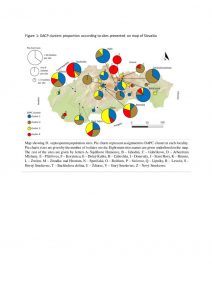 | Jánošíková, Z; Dutech, C; Ondrušková, E; Adamčíková, K; Mullett, M Population structure and genetic diversity of Dothistroma septosporum in Slovakia Journal Article European Journal of Plant Pathology, 160 (4), pp. 771-787, 2021, ISSN: 1573-8469. Abstract | Links | BibTeX @article{Jánošíková2021,
title = {Population structure and genetic diversity of Dothistroma septosporum in Slovakia},
author = {Z. Jánošíková and C. Dutech and E. Ondrušková and K. Adamčíková and M. Mullett},
url = {https://link.springer.com/article/10.1007/s10658-021-02266-z},
doi = {doi:10.1007/s10658-021-02266-z},
issn = {1573-8469},
year = {2021},
date = {2021-06-23},
journal = {European Journal of Plant Pathology},
volume = {160},
number = {4},
pages = {771-787},
abstract = {Dothistroma needle blight (DNB) is a serious pine disease present worldwide caused by the ascomycetous fungi Dothistroma septosporum and Dothistroma pini. Based on multiplex PCR analysis of 11 microsatellite markers screened on 253 D. septosporum isolates obtained from 32 sites across Slovakia, a total of 137 unique multilocus haplotypes (MLHs) were detected. The majority of MLHs (n = 91)
were represented by a single isolate, but 13 MLHs were found at two different sites, and in some cases, these were separated by large distances. Four population clusters were identified using a discriminant analysis of principal components (DAPC). The genetic clusters obtained from the DAPC were mixed throughout the country and were not restricted to particular host species. Although both mating types of D. septosporum were found to be in an almost perfect 1:1 ratio in both the non-clone-corrected and clone-corrected datasets, random mating was rejected in the entire dataset. Random mating was only supported in the Pinus mugo group planted in urban areas and on a smaller spatial scale in two sites (Kálnica and Litava) using the clonecorrected dataset. These findings suggest a mixed mode of reproduction with an important component of sexual reproduction, although the sexual stage of the fungus (teleomorph) has not been physically observed in Slovakia yet. The examination of spatial relationships using spatial principal component analyses and the presence of isolation-by-distance together with relatively high genetic diversity suggests the pathogen has been long established in Slovakia and spread naturally across the landscape. However, the weak population structure and findings of identical clones at widely separated sites strongly suggests some degree of human assisted dispersal.},
keywords = {},
pubstate = {published},
tppubtype = {article}
}
Dothistroma needle blight (DNB) is a serious pine disease present worldwide caused by the ascomycetous fungi Dothistroma septosporum and Dothistroma pini. Based on multiplex PCR analysis of 11 microsatellite markers screened on 253 D. septosporum isolates obtained from 32 sites across Slovakia, a total of 137 unique multilocus haplotypes (MLHs) were detected. The majority of MLHs (n = 91)
were represented by a single isolate, but 13 MLHs were found at two different sites, and in some cases, these were separated by large distances. Four population clusters were identified using a discriminant analysis of principal components (DAPC). The genetic clusters obtained from the DAPC were mixed throughout the country and were not restricted to particular host species. Although both mating types of D. septosporum were found to be in an almost perfect 1:1 ratio in both the non-clone-corrected and clone-corrected datasets, random mating was rejected in the entire dataset. Random mating was only supported in the Pinus mugo group planted in urban areas and on a smaller spatial scale in two sites (Kálnica and Litava) using the clonecorrected dataset. These findings suggest a mixed mode of reproduction with an important component of sexual reproduction, although the sexual stage of the fungus (teleomorph) has not been physically observed in Slovakia yet. The examination of spatial relationships using spatial principal component analyses and the presence of isolation-by-distance together with relatively high genetic diversity suggests the pathogen has been long established in Slovakia and spread naturally across the landscape. However, the weak population structure and findings of identical clones at widely separated sites strongly suggests some degree of human assisted dispersal. |
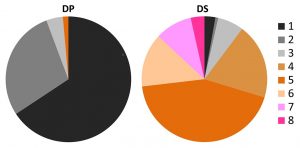 | Adamčíková, K; Ondrušková, E; Pažitný, J; Jánošíková, Z Divergence in culture morphology between two related species, Dothistroma septosporum and D. pini Journal Article Czech Mycology, 73 (1), pp. 109-119, 2021, ISSN: 1805-1421. Abstract | Links | BibTeX @article{Adamčíková2021,
title = {Divergence in culture morphology between two related species, Dothistroma septosporum and D. pini},
author = {K. Adamčíková and E. Ondrušková and J. Pažitný and Z. Jánošíková},
url = {http://ife.sk/wp-content/uploads/2020/09/fig.-2-rev-5.tif},
doi = {doi.org/10.33585/cmy.73108},
issn = {1805-1421},
year = {2021},
date = {2021-05-24},
journal = {Czech Mycology},
volume = {73},
number = {1},
pages = {109-119},
abstract = {Dothistroma needle blight (DNB) is one of the most important pine needle diseases worldwide. The disease is caused by two fungal species, Dothistroma septosporum and D. pini, which are similar not only in terms of their ecology, causing similar symptoms in hosts of the genus Pinus, but also
in terms of their morphological characteristics. The morphologies of 353 cultured Dothistroma isolates from 11 different pine species in Slovakia and their relation to Dothistroma species and/or fungus origin (host) were studied and evaluated by means of the Chi-square test. The cultures were classified into eight categories according to pigmentation. Dothistroma pini isolates were assigned to 4 of the 8 categories, and D. septosporum isolates were assigned to all 8 categories with varying frequencies. The Chi-square test revealed that the culture morphology categories of D. pini and D. septosporum differed significantly. Interactions between the evaluated factors (culture morphology, Dothistroma and host species) were analysed and showed significant differences.},
keywords = {},
pubstate = {published},
tppubtype = {article}
}
Dothistroma needle blight (DNB) is one of the most important pine needle diseases worldwide. The disease is caused by two fungal species, Dothistroma septosporum and D. pini, which are similar not only in terms of their ecology, causing similar symptoms in hosts of the genus Pinus, but also
in terms of their morphological characteristics. The morphologies of 353 cultured Dothistroma isolates from 11 different pine species in Slovakia and their relation to Dothistroma species and/or fungus origin (host) were studied and evaluated by means of the Chi-square test. The cultures were classified into eight categories according to pigmentation. Dothistroma pini isolates were assigned to 4 of the 8 categories, and D. septosporum isolates were assigned to all 8 categories with varying frequencies. The Chi-square test revealed that the culture morphology categories of D. pini and D. septosporum differed significantly. Interactions between the evaluated factors (culture morphology, Dothistroma and host species) were analysed and showed significant differences. |
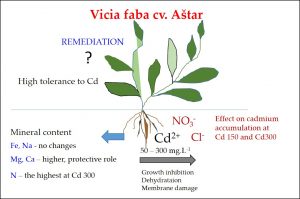 | Piršelová, B; Ondrušková, E Effect of Cadmium Chloride and Cadmium Nitrate on Growth and Mineral Nutrient Content in the Root of Fava Bean (Vicia faba L.) Journal Article Plants, 10 (5), pp. 1007, 2021. Abstract | Links | BibTeX @article{B.2021,
title = {Effect of Cadmium Chloride and Cadmium Nitrate on Growth and Mineral Nutrient Content in the Root of Fava Bean (Vicia faba L.)},
author = {B. Piršelová and E. Ondrušková},
editor = {Barceló J.},
url = {https://www.mdpi.com/2223-7747/10/5/1007},
doi = { https://doi.org/10.3390/plants10051007},
year = {2021},
date = {2021-05-18},
journal = {Plants},
volume = {10},
number = {5},
pages = {1007},
abstract = {The present study aimed to analyze the differences in the tolerance of fava bean (Vicia faba cv. Aštar) roots to cadmium in nitrate—Cd(NO3)2—and chloride—CdCl2—solutions. The physiological and biochemical parameters were assessed. The tested doses of Cd (50, 100, 150 and 300 mg/L) did not influence the germination of seeds. However, considerable growth inhibition and dehydration were observed after 96 h incubation. The thickness of roots and rupture of cell membranes increased along with the increasing concentration of the metal in the solution. At a Cd dose of 300 mg/L, irrespective of the solution used, increased nitrogen concentration and no change in sodium content were observed. The content of magnesium increased due to the dose of 100 mg/L (cadmium nitrate) and the content of calcium increased due to the dose of 300 mg/L (in either nitrate or chloride). The correlation analyses pointed to a possible effect of nitrates in the applied solutions on the accumulation of Cd and some minerals in the roots of the given variety of fava bean. This may be important for both research and agricultural practice. The identification of crops with high tolerance to cadmium, as well as knowledge about the mechanisms of ion interactions at the soil solution–plant level, is important in terms of such crops’ use in the process of the remediation of cadmium-contaminated soils coupled with food production.},
keywords = {},
pubstate = {published},
tppubtype = {article}
}
The present study aimed to analyze the differences in the tolerance of fava bean (Vicia faba cv. Aštar) roots to cadmium in nitrate—Cd(NO3)2—and chloride—CdCl2—solutions. The physiological and biochemical parameters were assessed. The tested doses of Cd (50, 100, 150 and 300 mg/L) did not influence the germination of seeds. However, considerable growth inhibition and dehydration were observed after 96 h incubation. The thickness of roots and rupture of cell membranes increased along with the increasing concentration of the metal in the solution. At a Cd dose of 300 mg/L, irrespective of the solution used, increased nitrogen concentration and no change in sodium content were observed. The content of magnesium increased due to the dose of 100 mg/L (cadmium nitrate) and the content of calcium increased due to the dose of 300 mg/L (in either nitrate or chloride). The correlation analyses pointed to a possible effect of nitrates in the applied solutions on the accumulation of Cd and some minerals in the roots of the given variety of fava bean. This may be important for both research and agricultural practice. The identification of crops with high tolerance to cadmium, as well as knowledge about the mechanisms of ion interactions at the soil solution–plant level, is important in terms of such crops’ use in the process of the remediation of cadmium-contaminated soils coupled with food production. |
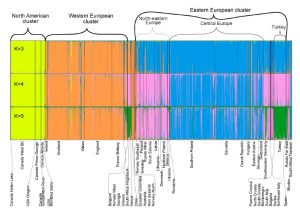 | Mullett, M S; Drenkhan, R; Adamson, K; Boroń, P; Lenart-Boroń, A; Barnes, I; Tomšovský, M; Jánošíková, Z; Adamčíková, K; Ondrušková, E; Queloz, V; Piškur, B; Musolin, D L; Davydenko, K; Georgieva, M; Schmitz, S; Kačergius, A; Ghelardini, L; Orlović, Kranjec J; Müller, M; Oskay, F; Hauptman, T; Halász, Á; Markovskaja, S; Solheim, H; Vuorinen, M; Heinzelmann, R; Hamelin, R C; Konečný, A Worldwide Genetic Structure Elucidates the Eurasian Origin and Invasion Pathways of Dothistroma septosporum, Causal Agent of Dothistroma Needle Blight Journal Article Journal of Fungi, 7 (2), pp. Article number: 111, 2021, ISBN: 2309-608X. Abstract | Links | BibTeX @article{Mullett2021,
title = {Worldwide Genetic Structure Elucidates the Eurasian Origin and Invasion Pathways of Dothistroma septosporum, Causal Agent of Dothistroma Needle Blight },
author = {M. S. Mullett and R. Drenkhan and K. Adamson and P. Boroń and A. Lenart-Boroń and I. Barnes and M. Tomšovský and Z. Jánošíková and K. Adamčíková and E. Ondrušková and V. Queloz and B. Piškur and D.L. Musolin and K. Davydenko and M. Georgieva and S. Schmitz and A. Kačergius and L. Ghelardini and J. Kranjec Orlović and M. Müller and F. Oskay and T. Hauptman and Á. Halász and S. Markovskaja and H. Solheim and M. Vuorinen and R. Heinzelmann and R.C. Hamelin and A. Konečný},
doi = {doi 10.3390/jof7020111 },
isbn = {2309-608X},
year = {2021},
date = {2021-02-03},
journal = {Journal of Fungi},
volume = {7},
number = {2},
pages = {Article number: 111},
abstract = {Dothistroma septosporum, the primary causal agent of Dothistroma needle blight, is one of the most significant foliar pathogens of pine worldwide. Its wide host and environmental ranges have led to its global success as a pathogen and severe economic damage to pine forests in many regions. This comprehensive global population study elucidated the historical migration pathways of the pathogen to reveal the Eurasian origin of the fungus. When over 3800 isolates were examined, three major population clusters were revealed: North America, Western Europe, and Eastern Europe, with distinct subclusters in the highly diverse Eastern European cluster. Modeling of historical scenarios using approximate Bayesian computation revealed the North American cluster was derived from an ancestral population in Eurasia. The Northeastern European subcluster was shown to be ancestral to all other European clusters and subclusters. The Turkish subcluster diverged first, followed by the Central European subcluster, then the Western European cluster, which has subsequently spread to much of the Southern Hemisphere. All clusters and subclusters contained both mating-types of the fungus, indicating the potential for sexual reproduction, although asexual reproduction remained the primary mode of reproduction. The study strongly suggests the native range of D. septosporum to be in Eastern Europe (i.e., the Baltic and Western Russia) and Western Asia.},
keywords = {},
pubstate = {published},
tppubtype = {article}
}
Dothistroma septosporum, the primary causal agent of Dothistroma needle blight, is one of the most significant foliar pathogens of pine worldwide. Its wide host and environmental ranges have led to its global success as a pathogen and severe economic damage to pine forests in many regions. This comprehensive global population study elucidated the historical migration pathways of the pathogen to reveal the Eurasian origin of the fungus. When over 3800 isolates were examined, three major population clusters were revealed: North America, Western Europe, and Eastern Europe, with distinct subclusters in the highly diverse Eastern European cluster. Modeling of historical scenarios using approximate Bayesian computation revealed the North American cluster was derived from an ancestral population in Eurasia. The Northeastern European subcluster was shown to be ancestral to all other European clusters and subclusters. The Turkish subcluster diverged first, followed by the Central European subcluster, then the Western European cluster, which has subsequently spread to much of the Southern Hemisphere. All clusters and subclusters contained both mating-types of the fungus, indicating the potential for sexual reproduction, although asexual reproduction remained the primary mode of reproduction. The study strongly suggests the native range of D. septosporum to be in Eastern Europe (i.e., the Baltic and Western Russia) and Western Asia. |
2020
|
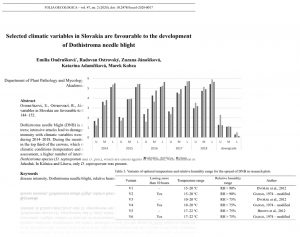 | Ondrušková, Emília; Ostrovský, Radovan; Jánošíková, Zuzana; Adamčíková, Katarína; Kobza, Marek Selected climatic variables in Slovakia are favourable to the development of Dothistroma needle blight Journal Article Folia Oecologica, 47 (2), pp. 144-152, 2020. Abstract | Links | BibTeX @article{Ondrušková2020b,
title = {Selected climatic variables in Slovakia are favourable to the development of Dothistroma needle blight},
author = {Emília Ondrušková and Radovan Ostrovský and Zuzana Jánošíková and
Katarína Adamčíková and Marek Kobza},
url = {http://ife.sk/wp-content/uploads/2020/09/foecol-2020-0008.pdf},
doi = {10.2478/foecol-2020-0017},
year = {2020},
date = {2020-11-24},
journal = {Folia Oecologica},
volume = {47},
number = {2},
pages = {144-152},
abstract = {Dothistroma needle blight (DNB) is a disease of pine needles. It causes significant defoliation of affected trees; intensive attacks lead to damages of the whole stand. The relationship of trends in disease severity and intensity with climatic variables were studied in three Austrian pine plantations (Jahodná, Kálnica, Litava) during 2014–2018. During the monitoring period, the greatest variability in disease severity was observed in the top third of the crowns, which showed the highest correlation with the variants of the most important climatic conditions (temperature and relative humidity) tested. For the spread of DNB, based on statistical assessment, a higher number of intervals of environmentally favourable climatic conditions is crucial. Both Dothistroma species (D. septosporum and D. pini), which are causal agents of the disease, were identified in Jahodná. In Kálnica and Litava, only D. septosporum was present.},
keywords = {},
pubstate = {published},
tppubtype = {article}
}
Dothistroma needle blight (DNB) is a disease of pine needles. It causes significant defoliation of affected trees; intensive attacks lead to damages of the whole stand. The relationship of trends in disease severity and intensity with climatic variables were studied in three Austrian pine plantations (Jahodná, Kálnica, Litava) during 2014–2018. During the monitoring period, the greatest variability in disease severity was observed in the top third of the crowns, which showed the highest correlation with the variants of the most important climatic conditions (temperature and relative humidity) tested. For the spread of DNB, based on statistical assessment, a higher number of intervals of environmentally favourable climatic conditions is crucial. Both Dothistroma species (D. septosporum and D. pini), which are causal agents of the disease, were identified in Jahodná. In Kálnica and Litava, only D. septosporum was present. |
2019
|
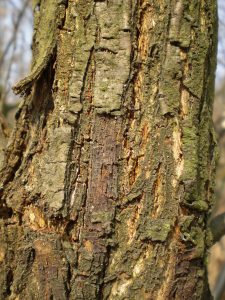 | K. Adamčíková E. Ondrušková, Kobza M Hypovirulence in chestnut blight fungus, Cryphonectria parasitica, in Slovakia Journal Article Biocontrol Science and Technology, 29 (9), pp. 840-851, 2019, ISSN: 0958-3157. Abstract | Links | BibTeX @article{Adamčíková2019,
title = {Hypovirulence in chestnut blight fungus, Cryphonectria parasitica, in Slovakia},
author = {K. Adamčíková, E. Ondrušková, M. Kobza},
doi = {DOI: 10.1080/09583157.2019.1608509},
issn = {0958-3157},
year = {2019},
date = {2019-07-19},
journal = {Biocontrol Science and Technology},
volume = {29},
number = {9},
pages = {840-851},
abstract = {The recovery of the European chestnut from chestnut blight in Europe is attributed to hypovirulence, a viral disease that reduces the virulence of its host – Cryphonectria parasitica. Hypovirulence has been used in biocontrol programmes throughout Europe with the aim of not only treating individual chestnut blight cankers but causing the natural spread and establishment of viruses in C. parasitica populations. Almost 40 years after the first appearance of chestnut blight and more than 20 years after the first biocontrol treatment implementation in Slovakia the establishment and natural spread of hypovirulence were studied. The morphological characteristics of 179 chestnut blight cankers and 161 C. parasitica strains were evaluated for the presence of hypovirus from three chestnut cultivation sites in Slovakia. Nineteen cankers and isolates were considered hypovirulent based on visual assessment of their morphological characteristics. The hypovirus presence by RNA extraction was confirmed in 6 cankers/strains.},
keywords = {},
pubstate = {published},
tppubtype = {article}
}
The recovery of the European chestnut from chestnut blight in Europe is attributed to hypovirulence, a viral disease that reduces the virulence of its host – Cryphonectria parasitica. Hypovirulence has been used in biocontrol programmes throughout Europe with the aim of not only treating individual chestnut blight cankers but causing the natural spread and establishment of viruses in C. parasitica populations. Almost 40 years after the first appearance of chestnut blight and more than 20 years after the first biocontrol treatment implementation in Slovakia the establishment and natural spread of hypovirulence were studied. The morphological characteristics of 179 chestnut blight cankers and 161 C. parasitica strains were evaluated for the presence of hypovirus from three chestnut cultivation sites in Slovakia. Nineteen cankers and isolates were considered hypovirulent based on visual assessment of their morphological characteristics. The hypovirus presence by RNA extraction was confirmed in 6 cankers/strains. |
2018
|
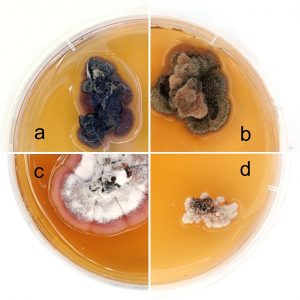 | Ondrušková, E; Jánošíková, Z; Adamčík, S; Kádasi-Horáková, M; Rákusová-Sládková, D; Adamčíková, K Needle blight caused by Dothistroma pini in Slovakia: distribution, host range and mating types Journal Article Scandinavian Journal of Forest Research, 33 (7), pp. 650-656, 2018, ISSN: 1651-1891. Abstract | Links | BibTeX @article{Ondrušková2018,
title = {Needle blight caused by Dothistroma pini in Slovakia: distribution, host range and mating types},
author = {E. Ondrušková and Z. Jánošíková and S. Adamčík and M. Kádasi-Horáková and D. Rákusová-Sládková and K. Adamčíková},
doi = {10.1080/02827581.2018.1482954},
issn = {1651-1891},
year = {2018},
date = {2018-06-06},
journal = {Scandinavian Journal of Forest Research},
volume = {33},
number = {7},
pages = {650-656},
abstract = {Dothistroma needle blight (DNB) has been observed in Slovakia during the last two decades. Up until 2017, Dothistroma septosporum has only been detected and molecularly confirmed to cause DNB in
Slovakia. Here, we report the detection of Dothistroma pini at six localities around Slovakia, representing different plantation types. Four pine species (Pinus sylvestris, P. nigra, P. mugo and P. jeffreyi) were confirmed as hosts of D. pini in Slovakia, of which only P. mugo has been previously reported as host in Slovakia. Three gene regions (ITS, EF1 –α, and ß-tubulin) of each of the 13 isolates were sequenced and assigned as D. pini. Based on ITS sequences, the studied isolates represent the haplotypes Dp_HAP.1, Dp_HAP.2. Both mating types were detected but at different localities. Our results suggest that in addition to D. septosporum, D. pini may contribute to DNB also in Slovakia.},
keywords = {},
pubstate = {published},
tppubtype = {article}
}
Dothistroma needle blight (DNB) has been observed in Slovakia during the last two decades. Up until 2017, Dothistroma septosporum has only been detected and molecularly confirmed to cause DNB in
Slovakia. Here, we report the detection of Dothistroma pini at six localities around Slovakia, representing different plantation types. Four pine species (Pinus sylvestris, P. nigra, P. mugo and P. jeffreyi) were confirmed as hosts of D. pini in Slovakia, of which only P. mugo has been previously reported as host in Slovakia. Three gene regions (ITS, EF1 –α, and ß-tubulin) of each of the 13 isolates were sequenced and assigned as D. pini. Based on ITS sequences, the studied isolates represent the haplotypes Dp_HAP.1, Dp_HAP.2. Both mating types were detected but at different localities. Our results suggest that in addition to D. septosporum, D. pini may contribute to DNB also in Slovakia. |
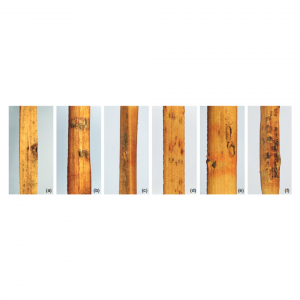 | Jánošíková-Hečková, Z; Ondrušková, E; Barta, M; Ostrovský, R; Kádasi-Horáková, M; Pastirčáková, K; Kobza, M; Adamčíková, K The hosts and geographic range of Dothistroma needle blight in Slovakia Journal Article Forest Pathology, 48 (3), pp. e12421, 2018, ISSN: 1437-4781. Abstract | Links | BibTeX @article{Jánošíková-Hečková2018,
title = {The hosts and geographic range of Dothistroma needle blight in Slovakia},
author = {Z. Jánošíková-Hečková and E. Ondrušková and M. Barta and R. Ostrovský and M. Kádasi-Horáková and K. Pastirčáková and M. Kobza and K. Adamčíková },
url = {https://onlinelibrary.wiley.com/doi/abs/10.1111/efp.12421},
doi = {10.1111/efp.12421},
issn = {1437-4781},
year = {2018},
date = {2018-02-15},
journal = {Forest Pathology},
volume = {48},
number = {3},
pages = {e12421},
abstract = {The occurrence and distribution of Dothistroma needle blight (DNB) were studied in 2014–2017 around Slovakia. A total of 84 localities, both native and planted, were investigated, and the presence of DNB was confirmed in 73 of them. In all positive locations, symptoms typical of DNB were observed and the Dothistroma species was confirmed using species-specific primers either from fungal cultures or directly from needles. Both Dothistroma species—D. septosporum and D. pini—were identified. Both species occurred together in 29 locations, only D. septosporum in 42 and only D. pini in two locations. The host range of D. septosporum included 10 pine species and two spruce species. The host range of D. pini comprised the same number of pine hosts but only one spruce species. Five pine hosts, P. aristata, P. coulteri, P. densiflora, P. jeffreyi, P. × schwerinii, and one spruce host P. abies are new hosts species of D. pini. P. densiflora and Picea pungens have earlier been reported to be susceptible for DNB. In this study, D. septosporum was found from both tree species.},
keywords = {},
pubstate = {published},
tppubtype = {article}
}
The occurrence and distribution of Dothistroma needle blight (DNB) were studied in 2014–2017 around Slovakia. A total of 84 localities, both native and planted, were investigated, and the presence of DNB was confirmed in 73 of them. In all positive locations, symptoms typical of DNB were observed and the Dothistroma species was confirmed using species-specific primers either from fungal cultures or directly from needles. Both Dothistroma species—D. septosporum and D. pini—were identified. Both species occurred together in 29 locations, only D. septosporum in 42 and only D. pini in two locations. The host range of D. septosporum included 10 pine species and two spruce species. The host range of D. pini comprised the same number of pine hosts but only one spruce species. Five pine hosts, P. aristata, P. coulteri, P. densiflora, P. jeffreyi, P. × schwerinii, and one spruce host P. abies are new hosts species of D. pini. P. densiflora and Picea pungens have earlier been reported to be susceptible for DNB. In this study, D. septosporum was found from both tree species. |
2017
|
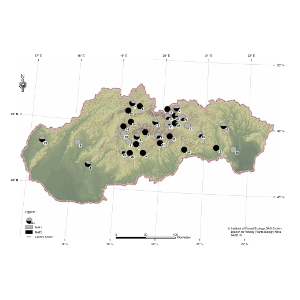 | Ondrušková, E; Hečková, Z; Kádasi-Horáková, M; Koltay, A; Ostrovský, R; Pažitný, J; Adamčíková, K Distribution and characterization of Dothistroma needle blight pathogens on Pinus mugo in Slovakia Journal Article European Journal of Plant Pathology, 148 (2), pp. 283-294, 2017, ISSN: 0929-1873. Abstract | Links | BibTeX @article{Ondrušková2017,
title = {Distribution and characterization of Dothistroma needle blight pathogens on Pinus mugo in Slovakia},
author = {E. Ondrušková and Z. Hečková and M. Kádasi-Horáková and A. Koltay and R. Ostrovský and J. Pažitný and K. Adamčíková},
url = {https://link.springer.com/article/10.1007/s10658-016-1088-2},
doi = {10.1007/s10658-016-1088-2},
issn = {0929-1873},
year = {2017},
date = {2017-01-01},
journal = {European Journal of Plant Pathology},
volume = {148},
number = {2},
pages = {283-294},
abstract = {The occurrence and distribution of Dothistroma needle blight (DNB) on Pinus mugo was studied in 2014–2015 around the Slovakia. In total, 42 localities were investigated both native and planted ones. Symptoms of DNB were observed on 35 localities only on planted shrubs. All these 35 localities are new P. mugo DNB stands. No DNB symptoms were observed in natural and naturally regenerated plantations. DNAwas extracted from a total of 236 isolates and eight needle samples. Based on the ITS-rDNA comparisons and using species specific primers, both pathogenic Dothistroma species were detected: D. septosporum and D. pini. Isolates of D. septosporum had ITS sequences identical to D. septosporum from Europe and both mating types were identified with slight predominance of MAT2. The ratio of D. septosporum mating types varies significantly between sites, ranging from an equal proportion of each mating type to single mating type populations. D. pini ITS sequence grouped with D. pini from Ukraine, Russia and Switzerland and only MAT2 was found.},
keywords = {},
pubstate = {published},
tppubtype = {article}
}
The occurrence and distribution of Dothistroma needle blight (DNB) on Pinus mugo was studied in 2014–2015 around the Slovakia. In total, 42 localities were investigated both native and planted ones. Symptoms of DNB were observed on 35 localities only on planted shrubs. All these 35 localities are new P. mugo DNB stands. No DNB symptoms were observed in natural and naturally regenerated plantations. DNAwas extracted from a total of 236 isolates and eight needle samples. Based on the ITS-rDNA comparisons and using species specific primers, both pathogenic Dothistroma species were detected: D. septosporum and D. pini. Isolates of D. septosporum had ITS sequences identical to D. septosporum from Europe and both mating types were identified with slight predominance of MAT2. The ratio of D. septosporum mating types varies significantly between sites, ranging from an equal proportion of each mating type to single mating type populations. D. pini ITS sequence grouped with D. pini from Ukraine, Russia and Switzerland and only MAT2 was found. |
2016
|
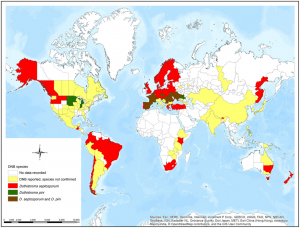 | Drenkhan, R; Tomešová‐Haataja, V; Fraser, S; Bradshaw, R E; Vahalík, P; Mullett, M S; Martín‐García, J; Bulman, L S; Wingfield, M J; Kirisits, T; Cech, T L; Schmitz, S; Baden, R; Tubby, K; Brown, A; Georgieva, M; Woods, A; Ahumada, R; Jankovský, L; Thomsen, I M; Adamson, K; Marçais, B; Vuorinen, M; Tsopelas, P; Koltay, A; Halasz, A; Porta, La N; Anselmi, N; Kiesnere, R; Markovskaja, S; Kačergius, A; Papazova‐Anakieva, I; Risteski, M; Sotirovski, K; Lazarević, J; Solheim, H; Boroń, P; Bragança, H; Chira, D; Musolin, D L; Selikhovkin, A V; Bulgakov, T S; Keča, N; Karadžić, D; Galovic, V; Pap, P; Markovic, M; Pajnik, Poljakovic L; Vasic, V; Ondrušková, E; Piškur, B; Sadiković, D; Diez, J J; Solla, A; Millberg, H; Stenlid, J; Angst, A; Queloz, V; Lehtijärvi, A; Doğmuş‐Lehtijärvi, H T; Oskay, F; Davydenko, K; Meshkova, V; Craig, D; Woodward, S; Barnes, I Global geographic distribution and host range of Dothistroma species : a comprehensive review Journal Article Forest Pathology : Journal de pathologie forestiere, 46 (5), pp. 408-442, 2016, ISSN: 1437-4781. Abstract | Links | BibTeX @article{Drenkhan2016,
title = { Global geographic distribution and host range of Dothistroma species : a comprehensive review},
author = {R. Drenkhan and V. Tomešová‐Haataja and S. Fraser and R. E. Bradshaw and P. Vahalík and M. S. Mullett and J. Martín‐García and L. S. Bulman and M. J. Wingfield and T. Kirisits and T. L. Cech and S. Schmitz and R. Baden and K. Tubby and A. Brown and M. Georgieva and A. Woods and R. Ahumada and L. Jankovský and I. M. Thomsen and K. Adamson and B. Marçais and M. Vuorinen and P. Tsopelas and A. Koltay and A. Halasz and N. La Porta and N. Anselmi and R. Kiesnere and S. Markovskaja and A. Kačergius and I. Papazova‐Anakieva and M. Risteski and K. Sotirovski and J. Lazarević and H. Solheim and P. Boroń and H. Bragança and D. Chira and D. L. Musolin and A. V. Selikhovkin and T. S. Bulgakov and N. Keča and D. Karadžić and V. Galovic and P. Pap and M. Markovic and L. Poljakovic Pajnik and V. Vasic and E. Ondrušková and B. Piškur and D. Sadiković and J. J. Diez and A. Solla and H. Millberg and J. Stenlid and A. Angst and V. Queloz and A. Lehtijärvi and H. T. Doğmuş‐Lehtijärvi and F. Oskay and K. Davydenko and V. Meshkova and D. Craig and S. Woodward and I. Barnes},
doi = {10.1111/efp.12290},
issn = {1437-4781},
year = {2016},
date = {2016-09-13},
journal = {Forest Pathology : Journal de pathologie forestiere},
volume = {46},
number = {5},
pages = {408-442},
abstract = {Dothistroma needle blight (DNB) is one of the most important diseases of pine. Although its notoriety stems from Southern Hemisphere epidemics in Pinus radiata plantations, the disease has increased in prevalence and severity in areas of the Northern Hemisphere, including Europe, during the last two decades. This increase has largely been attributed to expanded planting of susceptible hosts, anthropogenic dispersal of the causative pathogens and changes in climate conducive to disease development. The last comprehensive review of DNB was published in 2004, with updates on geographic distribution and host species in 2009. Importantly, the recognition that two species, Dothistroma septosporum and D. pini, cause DNB emerged only relatively recently in 2004. These two species are morphologically very similar, and DNA‐based techniques are needed to distinguish between them. Consequently, many records of host species affected or geographic location of DNB prior to 2004 are inconclusive or even misleading. The objectives of this review were (i) to provide a new database in which detailed records of DNB from 62 countries are collated; (ii) to chart the current global distribution of D. septosporum and D. pini; (iii) to list all known host species and to consider their susceptibility globally; (iv) to collate the published results of provenance trials; and (v) to consider the effects of site factors on disease incidence and severity. The review shows that DNB occurs in 76 countries, with D. septosporum confirmed to occur in 44 and D. pini in 13. There are now 109 documented Pinaceae host taxa for Dothistroma species, spanning six genera (Abies, Cedrus, Larix, Picea, Pinus and Pseudotsuga), with Pinus being the dominant host genus, accounting for 95 host taxa. The relative susceptibilities of these hosts to Dothistroma species are reported, providing a resource to inform species choice in forest planting. Country records show that most DNB outbreaks in Europe occur on Pinus nigra and its subspecies. It is anticipated that the collaborative work described in this review will both underpin a broader global research strategy to manage DNB in the future and provide a model for the study of other forest pathogens.},
keywords = {},
pubstate = {published},
tppubtype = {article}
}
Dothistroma needle blight (DNB) is one of the most important diseases of pine. Although its notoriety stems from Southern Hemisphere epidemics in Pinus radiata plantations, the disease has increased in prevalence and severity in areas of the Northern Hemisphere, including Europe, during the last two decades. This increase has largely been attributed to expanded planting of susceptible hosts, anthropogenic dispersal of the causative pathogens and changes in climate conducive to disease development. The last comprehensive review of DNB was published in 2004, with updates on geographic distribution and host species in 2009. Importantly, the recognition that two species, Dothistroma septosporum and D. pini, cause DNB emerged only relatively recently in 2004. These two species are morphologically very similar, and DNA‐based techniques are needed to distinguish between them. Consequently, many records of host species affected or geographic location of DNB prior to 2004 are inconclusive or even misleading. The objectives of this review were (i) to provide a new database in which detailed records of DNB from 62 countries are collated; (ii) to chart the current global distribution of D. septosporum and D. pini; (iii) to list all known host species and to consider their susceptibility globally; (iv) to collate the published results of provenance trials; and (v) to consider the effects of site factors on disease incidence and severity. The review shows that DNB occurs in 76 countries, with D. septosporum confirmed to occur in 44 and D. pini in 13. There are now 109 documented Pinaceae host taxa for Dothistroma species, spanning six genera (Abies, Cedrus, Larix, Picea, Pinus and Pseudotsuga), with Pinus being the dominant host genus, accounting for 95 host taxa. The relative susceptibilities of these hosts to Dothistroma species are reported, providing a resource to inform species choice in forest planting. Country records show that most DNB outbreaks in Europe occur on Pinus nigra and its subspecies. It is anticipated that the collaborative work described in this review will both underpin a broader global research strategy to manage DNB in the future and provide a model for the study of other forest pathogens. |
| Ivanová, H; Pristaš, P; Ondrušková, E Comparison of two Coniochaeta species (C. ligniaria and C. malacotricha) with a new pathogen of black pine needles - Sordaria macrospora Journal Article Plant Protection Science, 52 (1), pp. 18-25, 2016. BibTeX @article{Ivanová2016,
title = {Comparison of two Coniochaeta species (C. ligniaria and C. malacotricha) with a new pathogen of black pine needles - Sordaria macrospora},
author = {H. Ivanová and P. Pristaš and E. Ondrušková},
year = {2016},
date = {2016-01-01},
journal = {Plant Protection Science},
volume = {52},
number = {1},
pages = {18-25},
keywords = {},
pubstate = {published},
tppubtype = {article}
}
|
2015
|
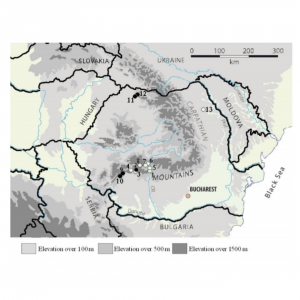 | Adamčíková, K; Ondrušková, E; Kádasi-Horáková, M; Botu, M; Kobza, M; Achim, G Distribution and population structure of the chestnut blight fungus in Romania Journal Article Plant Protection Science, 51 (3), pp. 141-149, 2015. Abstract | Links | BibTeX @article{Adamčíková2015,
title = {Distribution and population structure of the chestnut blight fungus in Romania},
author = {K. Adamčíková and E. Ondrušková and M. Kádasi-Horáková and M. Botu and M. Kobza and G. Achim},
url = {http://www.agriculturejournals.cz/publicFiles/157004.pdf},
doi = {10.17221/52/2014-PPS},
year = {2015},
date = {2015-01-01},
journal = {Plant Protection Science},
volume = {51},
number = {3},
pages = {141-149},
abstract = {The occurrence of chestnut blight (Cryphonectria parasitica) was studied in 2011-2012 at 13 locations in the main chestnut growing areas of Romania. Infections were detected at four localities. The symptoms and the fungus were detected on European chestnut (four localities) and also on oak trees (two localities). A total of 89 isolates of C. parasitica were isolated and characterised. Based on canker and isolate morphology (culture morphology and the Bavendamm test), both virulent and hypovirulent samples were isolated; hypovirulent isolates were found at only one locality. Two vegetative compatibility types corresponding to EU-12 and EU-2 were identified among isolates. Both mating types were found, with a dominance of MAT-1 in southern Romania and MAT-2 in northern Romania.},
keywords = {},
pubstate = {published},
tppubtype = {article}
}
The occurrence of chestnut blight (Cryphonectria parasitica) was studied in 2011-2012 at 13 locations in the main chestnut growing areas of Romania. Infections were detected at four localities. The symptoms and the fungus were detected on European chestnut (four localities) and also on oak trees (two localities). A total of 89 isolates of C. parasitica were isolated and characterised. Based on canker and isolate morphology (culture morphology and the Bavendamm test), both virulent and hypovirulent samples were isolated; hypovirulent isolates were found at only one locality. Two vegetative compatibility types corresponding to EU-12 and EU-2 were identified among isolates. Both mating types were found, with a dominance of MAT-1 in southern Romania and MAT-2 in northern Romania. |
2014
|
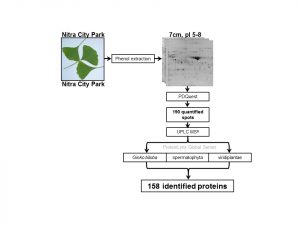 | Uváčková, Ľ; Ondrušková, E; Danchenko, M; Škultéty, Ľ; Miernyk, J A; Hrubík, P; Hajduch, M Establishing a leaf proteome reference map for Ginkgo biloba provides insight into potential ethnobotanical uses Journal Article Journal of Agricultural and Food Chemistry, 62 (47), pp. 11547–11556, 2014. Abstract | Links | BibTeX @article{Ľ.2014b,
title = {Establishing a leaf proteome reference map for Ginkgo biloba provides insight into potential ethnobotanical uses},
author = {Ľ. Uváčková and E. Ondrušková and M. Danchenko and Ľ. Škultéty and J.A. Miernyk and P. Hrubík and M. Hajduch},
url = {https://www.ncbi.nlm.nih.gov/pubmed/25365400},
year = {2014},
date = {2014-11-26},
journal = {Journal of Agricultural and Food Chemistry},
volume = {62},
number = {47},
pages = {11547–11556},
abstract = {Ginkgo (Maidenhair tree, Ginkgo biloba L.), is an ancient medicinal and ornamental tree. However, systematic proteomics study of ginkgo leaves is still missing. Herein we performed initial study of ginkgo leaf proteome and established reference map. Proteins were isolated from fully developed mature leaves in biological triplicate and analyzed with two-dimensional gel electrophoresis in combination with tandem mass spectrometry and intensive bioinformatics. This approach reliably quantified 190 protein spots out of which 158 proteins were identified by mass spectrometry. These proteins were used to establish the reference map of ginkgo leaf proteome. Most of identified proteins were associated with Energy followed by Protein Destination and Storage. The identity of
identified proteins confirmed accumulation of flavonoids and other phenolic compounds in mature leaves. This study also revealed proteins whose function is not yet known. Interestingly, second most abundant unknown protein was found to be similar to protein characterized in the king cobra. Proteins with unknown function detected in this study constitute pool of potential targets for metabolic
engineering.
},
keywords = {},
pubstate = {published},
tppubtype = {article}
}
Ginkgo (Maidenhair tree, Ginkgo biloba L.), is an ancient medicinal and ornamental tree. However, systematic proteomics study of ginkgo leaves is still missing. Herein we performed initial study of ginkgo leaf proteome and established reference map. Proteins were isolated from fully developed mature leaves in biological triplicate and analyzed with two-dimensional gel electrophoresis in combination with tandem mass spectrometry and intensive bioinformatics. This approach reliably quantified 190 protein spots out of which 158 proteins were identified by mass spectrometry. These proteins were used to establish the reference map of ginkgo leaf proteome. Most of identified proteins were associated with Energy followed by Protein Destination and Storage. The identity of
identified proteins confirmed accumulation of flavonoids and other phenolic compounds in mature leaves. This study also revealed proteins whose function is not yet known. Interestingly, second most abundant unknown protein was found to be similar to protein characterized in the king cobra. Proteins with unknown function detected in this study constitute pool of potential targets for metabolic
engineering.
|
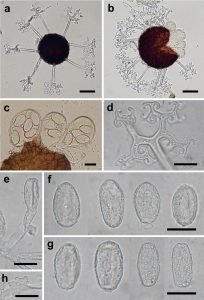 | Ondrušková, E; Juhásová, G; Pastirčáková, K The lily magnolia powdery mildew Erysiphe magnifica found in Slovakia Journal Article Mycotaxon, 127 , pp. 51-57, 2014, ISSN: 0093-4666. Abstract | Links | BibTeX @article{E.2014,
title = {The lily magnolia powdery mildew \textit{Erysiphe magnifica} found in Slovakia},
author = {E. Ondrušková and G. Juhásová and K. Pastirčáková},
url = {http://www.ingentaconnect.com/contentone/mtax/mt/2014/00000127/00000001/art00010},
doi = {10.5248/127.51},
issn = {0093-4666},
year = {2014},
date = {2014-03-01},
journal = {Mycotaxon},
volume = {127},
pages = {51-57},
abstract = {Powdery mildew symptoms were observed on leaves of lily magnolia (Magnolia liliiflora) in Slovakia. The causal fungus was identified as Erysiphe magnifica based on the morphology of both anamorphic and teleomorphic stages. This is the first report of E. magnifica on lily magnolia in Slovakia. A detailed description, illustrations, the host range, and the distribution of this fungus are given.},
keywords = {},
pubstate = {published},
tppubtype = {article}
}
Powdery mildew symptoms were observed on leaves of lily magnolia (Magnolia liliiflora) in Slovakia. The causal fungus was identified as Erysiphe magnifica based on the morphology of both anamorphic and teleomorphic stages. This is the first report of E. magnifica on lily magnolia in Slovakia. A detailed description, illustrations, the host range, and the distribution of this fungus are given. |
![Gaštan jedlý na Slovensku a v Európe : pestovanie, ochrana, variabilita a využitie [European chestnut in Slovakia : growing, protection, use and genetic variability]](http://ife.sk/wp-content/uploads/2016/10/IFE_adamcikova_katarina_article_08.jpg) | Adamčíková, K; Kobza, M; Juhásová, G; Ondrušková, E; Bolvanský, M; Kádasi-Horáková, M Gaštan jedlý na Slovensku a v Európe : pestovanie, ochrana, variabilita a využitie [European chestnut in Slovakia : growing, protection, use and genetic variability] Book Garamond, Nitra, 2014, ISBN: 978-80-89408-18-4. BibTeX @book{Adamčíková2014,
title = {Gaštan jedlý na Slovensku a v Európe : pestovanie, ochrana, variabilita a využitie [European chestnut in Slovakia : growing, protection, use and genetic variability]},
author = {K. Adamčíková and M. Kobza and G. Juhásová and E. Ondrušková and M. Bolvanský and M. Kádasi-Horáková},
isbn = {978-80-89408-18-4},
year = {2014},
date = {2014-01-01},
volume = {1},
pages = {155},
publisher = {Garamond},
address = {Nitra},
keywords = {},
pubstate = {published},
tppubtype = {book}
}
|
2013
|
![Diversity of microfungi on branches of Castanea sativa in Slovakia [Diverzita mikroskopických húb na konároch Castanea sativa na Slovensku]](http://ife.sk/wp-content/uploads/2016/10/g4646.png) | Adamčíková, K; Juhásová, G; Kobza, M; Ondrušková, E Diversity of microfungi on branches of Castanea sativa in Slovakia [Diverzita mikroskopických húb na konároch Castanea sativa na Slovensku] Journal Article Polish Botanical Journal, 58 (2), pp. 741-746, 2013, ISSN: 1641-8180. Abstract | BibTeX @article{Adamčíková2013,
title = {Diversity of microfungi on branches of Castanea sativa in Slovakia [Diverzita mikroskopických húb na konároch Castanea sativa na Slovensku]},
author = {K. Adamčíková and G. Juhásová and M. Kobza and E. Ondrušková},
issn = {1641-8180},
year = {2013},
date = {2013-01-01},
journal = {Polish Botanical Journal},
volume = {58},
number = {2},
pages = {741-746},
abstract = {Localities in Castanea sativa Mill. plantations were visited in a study aimed at identifying the mycoflora of C. sativa in Slovakia [excluding Cryphonectria parasitica (Murr.), Barr for which much data is available]. Samples from chestnut tree branches and stems were examined visually and microscopically. Seven species of microfungi were recorded, three with their anamorphs. Coryneum modonium (Sacc.) Griffon & Maubl. and Phomopsis castaneae Woron. were the most common. Libertella quercina Tul. & C. Tul. was identified in both states (anamorph and teleomorph) at two new localities. The records of Gloniopsis praelonga (Schwein.) Underw. & Earle and Dothidotthia celtidis (Ellis & Everh.) M. E. Barr are the first for Slovakia. These species were rare, found only in one locality. Two microscopic fungi were detected: Valsa ambiens (Pers.) Fr. [Cytospora leucosperma (Pers.) Fr.] and Diplodina castaneae Prill. & Delacr.},
keywords = {},
pubstate = {published},
tppubtype = {article}
}
Localities in Castanea sativa Mill. plantations were visited in a study aimed at identifying the mycoflora of C. sativa in Slovakia [excluding Cryphonectria parasitica (Murr.), Barr for which much data is available]. Samples from chestnut tree branches and stems were examined visually and microscopically. Seven species of microfungi were recorded, three with their anamorphs. Coryneum modonium (Sacc.) Griffon & Maubl. and Phomopsis castaneae Woron. were the most common. Libertella quercina Tul. & C. Tul. was identified in both states (anamorph and teleomorph) at two new localities. The records of Gloniopsis praelonga (Schwein.) Underw. & Earle and Dothidotthia celtidis (Ellis & Everh.) M. E. Barr are the first for Slovakia. These species were rare, found only in one locality. Two microscopic fungi were detected: Valsa ambiens (Pers.) Fr. [Cytospora leucosperma (Pers.) Fr.] and Diplodina castaneae Prill. & Delacr. |
2012
|
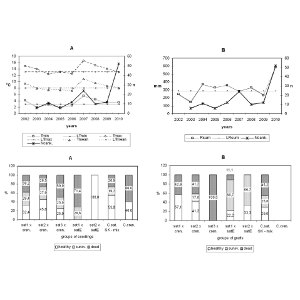 | Adamčíková, K; Kobza, M; Bolvanský, M; Ondrušková, E Spread and population structure of Cryphonectria parasitica in a young chestnut orchard in Slovakia Journal Article Central European Journal of Biology, 7 (2), pp. 267–274, 2012. Abstract | Links | BibTeX @article{K.2012,
title = {Spread and population structure of \textit{Cryphonectria parasitica} in a young chestnut orchard in Slovakia},
author = {K. Adamčíková and M. Kobza and M. Bolvanský and E. Ondrušková},
url = {http://link.springer.com/article/10.2478/s11535-012-0009-4},
year = {2012},
date = {2012-02-10},
journal = {Central European Journal of Biology},
volume = {7},
number = {2},
pages = {267–274},
abstract = {The chestnut blight pathogen Cryphonectria parasitica was studied in a chestnut collection composed of both seedlings and grafts derived from selected Castanea sativa and C. sativa x C. crenata trees located in south-east Slovakia, near village Príbelce on an area of approximately 3.5 ha. The study was conducted during eight years (2003-2010). During this period 133 trees were infected, which represents 59.82% of chestnut trees of all chestnut accessions. Based on the phenotype of the fungus culture and the type of cankers in the field, all isolates were determined to be virulent. No hypovirulent strains were found. No vegetative compatibility (vc) type diversity was observed. More than 130 isolates were analyzed for vc and all were in single vc type, which was identical with EU 12. All isolates assayed for mating type were MAT-1. No perithecia were observed. No significant differences were found between the proportion of cankered and dead cankered trees in seedlings and grafts of hybrid origin (C. sativa x C. crenata) and of C. sativa origin. However, particular seedlings and grafts of hybrid origin seemed to exhibit certain resistance to chestnut blight.},
keywords = {},
pubstate = {published},
tppubtype = {article}
}
The chestnut blight pathogen Cryphonectria parasitica was studied in a chestnut collection composed of both seedlings and grafts derived from selected Castanea sativa and C. sativa x C. crenata trees located in south-east Slovakia, near village Príbelce on an area of approximately 3.5 ha. The study was conducted during eight years (2003-2010). During this period 133 trees were infected, which represents 59.82% of chestnut trees of all chestnut accessions. Based on the phenotype of the fungus culture and the type of cankers in the field, all isolates were determined to be virulent. No hypovirulent strains were found. No vegetative compatibility (vc) type diversity was observed. More than 130 isolates were analyzed for vc and all were in single vc type, which was identical with EU 12. All isolates assayed for mating type were MAT-1. No perithecia were observed. No significant differences were found between the proportion of cankered and dead cankered trees in seedlings and grafts of hybrid origin (C. sativa x C. crenata) and of C. sativa origin. However, particular seedlings and grafts of hybrid origin seemed to exhibit certain resistance to chestnut blight. |
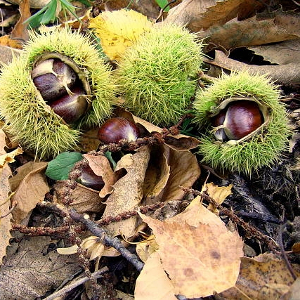 | Juhásová, G; Adamčíková, K; Bolvanský, M; Ivanová, H; Tokár, F; Hrubík, P; Konôpková, J; Kobza, M; Ondrušková, M; Kollár, J; Kunová, A Gaštan jedlý na Slovensku. Perspektívy jeho ochrany a pestovania. Book Garmond, Nitra, 2012, ISBN: 978-80-89408-14-6 1. BibTeX @book{Juhásová2012,
title = {Gaštan jedlý na Slovensku. Perspektívy jeho ochrany a pestovania.},
author = {G. Juhásová and K. Adamčíková and M. Bolvanský and H. Ivanová and F. Tokár and P. Hrubík and J. Konôpková and M. Kobza and M. Ondrušková and J. Kollár and A. Kunová},
isbn = {978-80-89408-14-6 1},
year = {2012},
date = {2012-01-01},
pages = {156},
publisher = {Garmond},
address = {Nitra},
keywords = {},
pubstate = {published},
tppubtype = {book}
}
|





















![Gaštan jedlý na Slovensku a v Európe : pestovanie, ochrana, variabilita a využitie [European chestnut in Slovakia : growing, protection, use and genetic variability]](http://ife.sk/wp-content/uploads/2016/10/IFE_adamcikova_katarina_article_08.jpg)
![Diversity of microfungi on branches of Castanea sativa in Slovakia [Diverzita mikroskopických húb na konároch Castanea sativa na Slovensku]](http://ife.sk/wp-content/uploads/2016/10/g4646.png)


